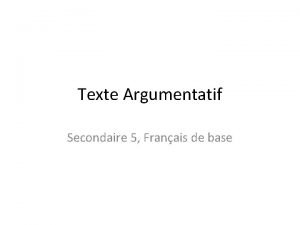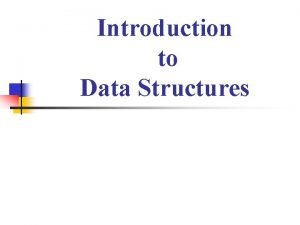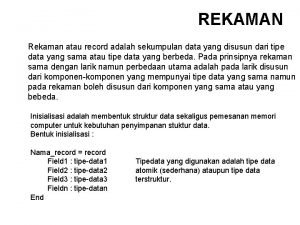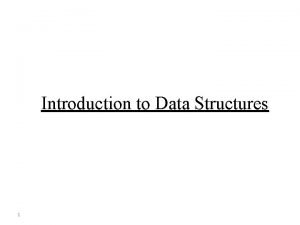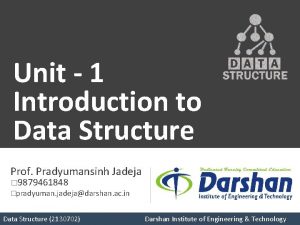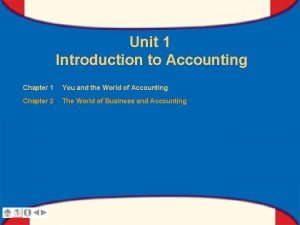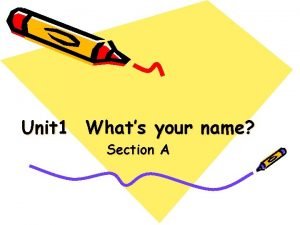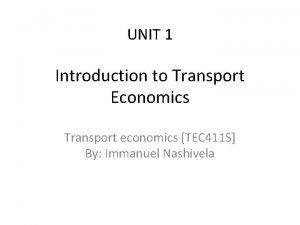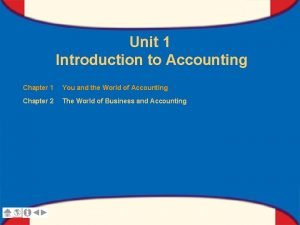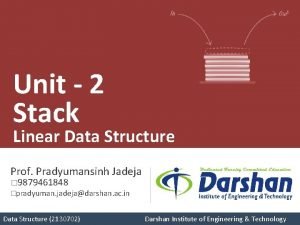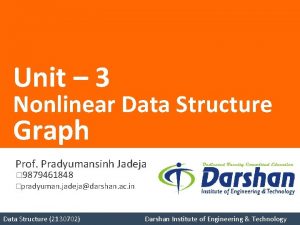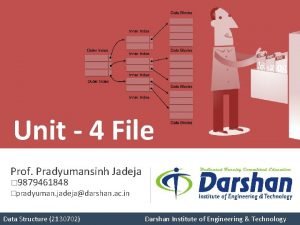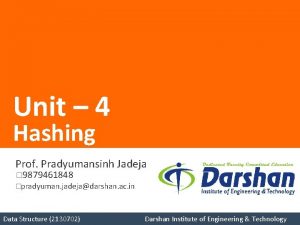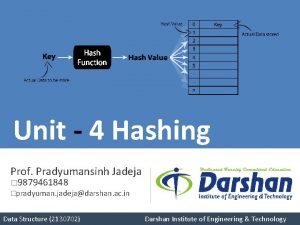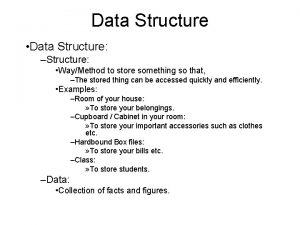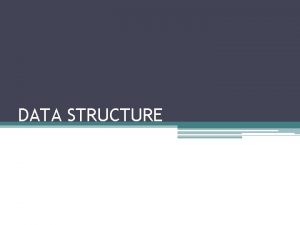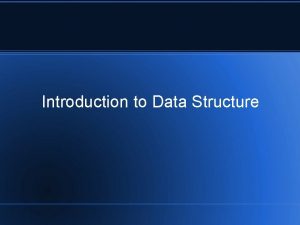Unit 1 Introduction to Data Structure Prof Pradyumansinh















- Slides: 15

Unit - 1 Introduction to Data Structure Prof. Pradyumansinh Jadeja � 9879461848 �pradyuman. jadeja@darshan. ac. in Data Structure (2130702) Darshan Institute of Engineering & Technology

Topics to be covered § Data Management concepts § Data types • Primitive • Non-primitive § Types of Data Structures • Linear Data Structures • Non Linear Data Structures § Performance Analysis and Measurement • Time analysis of algorithms • Space analysis of algorithms Unit – 1: Introduction to Data Structure 2 Darshan Institute of Engineering & Technology

What is Data? § Data is the basic fact or entity that is utilized in calculation or manipulation § There are two different types of data Numeric data and alphanumeric data § When a programmer collects such type of data for processing, he would require to store them in computer’s main memory. § The process of storing data items in computer’s main memory is called representation § Data to be processed must be organized in a particular fashion, these organization leads to structuring of data, and hence the mission to study the Data Structures Unit – 1: Introduction to Data Structure 3 Darshan Institute of Engineering & Technology

What is Data Structure? § Data Structure is a representation of the logical relationship existing between individual elements of data. § In other words, a data structure is a way of organizing all data items that considers not only the elements stored but also their relationship to each other § We can also define data structure as a mathematical or logical model of a particular organization of data items § Data Structure mainly specifies the following four things • Organization of Data • Accessing Methods • Degree of Associativity • Processing alternatives for information Unit – 1: Introduction to Data Structure 4 Darshan Institute of Engineering & Technology

What is Data Structure? Cont. . § The representation of a particular data structure in the memory of a computer is called Storage Structure § The storage structure representation in auxiliary memory is called as File Structure Algorithm Data Structure Unit – 1: Introduction to Data Structure 5 Program Darshan Institute of Engineering & Technology

Classification of Data Structure Primitive Data Structure Integer Non-Primitive Data Structure Characters Floating Point Arrays Pointers Linear List Stack Unit – 1: Introduction to Data Structure 6 Lists Files Non-linear List Queue Graphs Trees Darshan Institute of Engineering & Technology

Primitive/Non-primitive data structures § Primitive data structures • Primitive data structures are basic structures and are directly operated upon by machine instructions • Integers, floats, character and pointers are examples of primitive data structures § Non primitive data structure • These are derived from primitive data structures • The non-primitive data structures emphasize on structuring of a group of homogeneous or heterogeneous data items • Examples of Non-primitive data type are Array, List, and File Unit – 1: Introduction to Data Structure 7 Darshan Institute of Engineering & Technology

Non primitive Data Structure § Array: An array is a fixed-size sequenced collection of elements of the same data type. § List: An ordered set containing variable number of elements is called as Lists. § File: A file is a collection of logically related information. It can be viewed as a large list of records consisting of various fields. Array File List Unit – 1: Introduction to Data Structure 8 Darshan Institute of Engineering & Technology

Linear / Non-Linear data structure § Linear data structures • A data structure is said to be Linear, if its elements are connected in linear fashion by means of logically or in sequence memory locations • Examples of Linear Data Structure are Stack and Queue. § Nonlinear data structures • Nonlinear data structures are those data structure in which data items are not arranged in a sequence • Examples of Non-linear Data Structure are Tree and Graph Stack Queue Unit – 1: Introduction to Data Structure Tree 9 Graph Darshan Institute of Engineering & Technology

Operations of Data Structure § Create: it results in reserving memory for program elements § Destroy: it destroys memory space allocated for specified data structure § Selection: it deals with accessing a particular data within a data structure § Updation: it updates or modifies the data in the data structure § Searching: it finds the presence of desired data item in the list of data items Unit – 1: Introduction to Data Structure 10 Darshan Institute of Engineering & Technology

Operations of Data Structure Cont… § Sorting: it is a process of arranging all data items in a data structure in a particular order § Merging: it is a process of combining the data items of two different sorted list into a single sorted list § Splitting: it is a process of partitioning single list to multiple list § Traversal: it is a process of visiting each and every node of a list in systematic manner Unit – 1: Introduction to Data Structure 11 Darshan Institute of Engineering & Technology

Time and space analysis of algorithms § Sometimes, there are more than one way to solve a problem. § We need to learn how to compare the performance different algorithms and choose the best one to solve a particular problem. § While analyzing an algorithm, we mostly consider time complexity and space complexity § Time complexity of an algorithm quantifies the amount of time taken by an algorithm to run as a function of the length of the input Unit – 1: Introduction to Data Structure 12 Darshan Institute of Engineering & Technology

Time and space analysis of algorithms § Space complexity of an algorithm quantifies the amount of space or memory taken by an algorithm to run as a function of the length of the input § Time & space complexity depends on lots of things like hardware, operating system, processors, etc. § However, we don't consider any of these factors while analyzing the algorithm. We will only consider the execution time of an algorithm Unit – 1: Introduction to Data Structure 13 Darshan Institute of Engineering & Technology

Calculate Time Complexity of Algorithm § Time Complexity is most commonly estimated by counting the number of elementary functions performed by the algorithm § Since the algorithm's performance may vary with different types of input data, • hence for an algorithm we usually use the worst-case Time complexity of an algorithm because that is the maximum time taken for any input size Unit – 1: Introduction to Data Structure 14 Darshan Institute of Engineering & Technology

Calculating Time Complexity § Calculate Time Complexity of Sum of elements of List (One dimensional Array) Sum. Of. List(A, n) { Line 1 total = 0 Line 2 for i = 0 to n-1 Line 3 total = total + A[i] Line 4 return total } TSum. Of. List = 1 + 2 (n+1) + 2 n + 1 = 4 n + 4 =n A is array, n is no of elements in array Line Cost No of Times 1 1 1 2 3 2 2 n+1 n 4 1 1 We can neglate constant 4 Time complexity of given algorithm is n unit time Unit – 1: Introduction to Data Structure 15 Darshan Institute of Engineering & Technology
 Static data structure and dynamic data structure
Static data structure and dynamic data structure Body paragraph structure
Body paragraph structure Unit 6 review questions
Unit 6 review questions Texte argumentatif exemple secondaire 4
Texte argumentatif exemple secondaire 4 Classification of data structure
Classification of data structure Rekaman data adalah
Rekaman data adalah Introduction to data mining and data warehousing
Introduction to data mining and data warehousing Elementary data organization in data structure
Elementary data organization in data structure How to calculate time complexity in data structure
How to calculate time complexity in data structure Unit 1 introduction to accounting
Unit 1 introduction to accounting Unit 1 introduction names and terms to know
Unit 1 introduction names and terms to know Unit 1 introduction to logistics
Unit 1 introduction to logistics Unit 1 introduction to accounting
Unit 1 introduction to accounting Unit 1 economics
Unit 1 economics The renaissance 1485-1660
The renaissance 1485-1660 The middle ages 1066 to 1485 unit introduction
The middle ages 1066 to 1485 unit introduction



